It seems like every few months, another press release is made by Kodak or Fuji with bad news about some film stock that is being discontinued and others that are getting price increases. These announcements inevitably launch a buying frenzy of still available films that quickly deplete available inventories at most retail locations that sell film.
- In May 2019, Fuji announced a July price hike of 30% on all available films including Velvia, Provia, and Superia. Madness ensued.
- November of that same year, Kodak Alaris did the same thing, effective January 2020. Madness ensued.
- Not to be outdone, in April 2020, Harman announced increases of all products from it’s Ilford and Kentmere brands. Madness ensued.
- In November 2020, as a direct result of COVID-19 supply problems, Kodak announced another increase effective January 2021. Madness ensued.
- And most recently, Kodak Alaris once again announced “significant” price increases effective January 2022 on all it’s films. Madness is currently ensuing.
- Edit 4/2/2022: Once again, Fuji announces price hikes up to 60% on film stocks. Madness is off the charts!
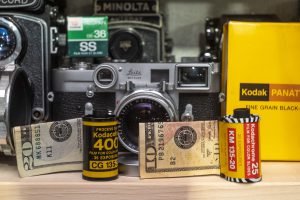
Each time an announcement was made, film photography blogs were quick to make their own posts about each increase, some offering suggestions on how to stretch your buying dollar by considering bulk film, buying expired film on eBay, or shooting half frame.
The reasons for these increases are complicated, but most certainly have to do with a shift in the buying habits of consumers, along with supply problems as a result of the ongoing COVID-19 pandemic. Companies like Fuji make far more money off their other products than they do film, and sometimes it just makes sense to wind down a low profit product, which causes prices to go up.
As I read these announcements, response from the film community varies from “meh”, to complete hysteria, and it got me wondering how today’s prices compare to that of film in the past. Certainly inflation has played a role in the rising costs of film, but by how much?
Having a huge resource of historical information at my fingertips in my reviews and research material, I thought it would be fun to look back at what film used to cost, and using the Consumer Price Index’s inflation calculator, see how those prices compare to today.
Disclaimer: Before I begin, I should point out that comparisons between the films you can get today and those from the past are not exactly apples to apples. Films like Kodak E100 (Ektachrome) and Ilford HP5 which have been around for a very long time have evolved with changes to their emulsions, and likely have wildly different manufacturing costs. Kodak ColorPlus 200 is a modern general purpose color film, but is not the same thing as films like Kodak Gold 200 or Kodacolor II which came before it. So while it’s not fair to compare 1970s prices of Kodacolor to 2021 prices of ColorPlus, I do believe that general comparisons between films of a similar type and market are valid, which is what I am doing in this article.
1888 Kodak
If we’re looking at historical film prices, I think an appropriate place to start was with Kodak’s first film camera, the simply named, “Kodak” camera from 1888. I’ve written an in depth article/review about the 1888 Kodak that explains it’s history and how it worked, which I definitely recommend you check out, but in a nutshell, this was an early box camera sold preloaded with an early type of roll film that made up to 100 exposures before it needed to be changed.
Although the film could be bought and reloaded by the end user, this was not the intent of the camera. Most owners of the 1888 Kodak bought the camera and upon finishing the roll, would send the entire camera back to Kodak where it would be unloaded, the film developed and mounted, the camera reloaded, and sent back to the owner. All of this cost $10 which for the time was a lot cheaper than going to a professional photo studio and getting a glass or tin type photo made.
Most references to reloading the camera refer to this same $10 price, but the receipt above from December 1892 breaks down the cost of what is included in the price. We can see that the actual film charge is only $2.50, which suggests that’s what you could buy a 100 exposure roll of film for separately if you chose to develop and reload the camera yourself.
Since each roll was 100 exposures, we can roughly say that for $2.50, you got the equivalent of three 36-exposure rolls of black and white film for 83.3 cents each.
The CPI Inflation Calculator on the US Bureau of Labor Statistics website does not go back to 1888, so I had to use a different one, but suggests that 83.3 cents in 1888 is worth nearly $24 today.
1913 Kodak Price List
By the first decade of the 20th century, film use among amateurs and professionals exploded. In less than two decades, roll film went from a single format, to more than a dozen, with exposure sizes as small as 1.5×2 inches all the way to 5×7 inches.
The price list to the right is undated, but the presence of 127 Vest Pocket film which made it’s debut in the Vest Pocket Kodak of 1912, suggests this price list is from that time.
Assuming a date of 1913, which is convenient as it’s the first year the CPI Calculator allows, we see prices from 15 cents for a 6-exposure roll of 121 format roll film to 90 cents for 12-exposure rolls of 104 and 123 format roll film.
Most of these film sizes did not survive the first half of the 20th century, but of the ones that did, an 8-exposure roll of 127 “Vest Pocket” film was 20 cents and a 12-exposure roll of 120 was 40 cents.
Using the CPI calculator and a date of January 1913, these prices compare to $5.60 and $11.20 today, which aren’t that far off from current single roll prices of medium format film.
It should be noted that these prices pre-date Eastman Kodak’s inclusion of processing with each roll of film. In the 1910s when this chart was likely made, processing costs were separate, as they are today.
1912 Kodak Brownie
Although not nearly as interesting as the large price list to the right, Kodak’s 1912 catalog lists these same prices for six and twelve exposure rolls of film for the Kodak No.2 Brownie.
Kodachrome
So far, we’ve only looked at black and white films as color film was not readily available until the 1930s. Although some earlier formats did exist prior, the most commonly remembered early color film was Kodachrome.
When it was first announced on April 15, 1935, Kodachrome was a big deal. For the time, it was the highest quality color film available. It produced accurate and vibrant colors that ushered in a new era of photography. A lush field of flowers or a bright yellow dress could now be seen in full color, compared to earlier processes that usually required hand dyes or primitive 2-color emulsions.
For as pioneering of a film Kodachrome was, it was also very expensive. In Keppler’s Vault 82, which reflected back on the 50th anniversary of Kodachrome, I quoted a special 19 page feature article from the September 1985 issue of Modern Photography, celebrating Kodachrome’s 50th anniversary that says:
When it was first released, Kodachrome was only available in 16mm, as a six layer emulsion with a RemJet backing, intended for motion picture films. The first still film Kodachrome wouldn’t be available until September 1936 when it was released in both Kodak’s new 135 daylight loading cassette and 8 exposure 828 roll film format. The speed of the first Kodachrome was daylight balanced at ASA 8, comparable to Kodak’s Panchromatic black and white film. An 18 exposure roll of Kodachrome 35mm film sold for $3.50 and $1.75 for the 828 version, both prices included development by Kodak. When adjusted for inflation, these prices compare to $65 and $32.50 respectively, an incredible amount for a single roll of film.
At prices of between $32 to $65 for a single roll of film, including developing, it was out of reach of all but the most professional photographers. It would take a world war and nearly two decades after the release of Kodachrome for prices to come down to a point where the average family snapshooter could afford a roll, and even then it was still expensive. Check out the whole article below if you want to learn more about the history of Kodachrome.
Kodachrome (January 1954)
By 1954, photography was getting cheaper, not only for film, but also the cameras that used it. In the United States, Eastman Kodak had a large stake in the market for inexpensive, but good cameras that came with lenses and shutters that could take advantage of the vibrant colors Kodachrome offered.
In the ad to the right from January 1954, the prices for Kodachrome were $1.88 for an 8-expsure roll of 828 format roll film, $3.50 for a 20-exposure roll of 35mm, and $5.50 for a 36-exposure roll of film 35mm. Developing and slide mounting was included.
When adjusted for inflation, these prices compare to $19.17, $35.69, and $56.09 today.
Even taking into account developing and slide mounting, the idea of spending over fifty bucks to shoot a single roll of film is mind boggling. For those who would have paid the expense, they likely reserved these rolls for very special occasions like family vacations, weddings, or special anniversaries as making color selfies or images of your dinner would have seemed ridiculous at the time!
ANSCO Film 1960
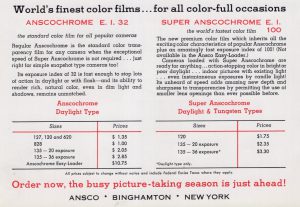 So far, we’ve only looked at Kodak films, but what about their competitors?
So far, we’ve only looked at Kodak films, but what about their competitors?
In an ANSCO 1960 Dealer price guide found on Pacific Rim’s reference library, prices for ANSCO’s Anscochrome 32 and Super Anscochrome 100 transparency films are as follows.
- 120 Roll Film – $1.35 and $1.75
- 20 exposure 35mm – $2.05 and $2.35
- 36 exposure 35mm – $2.85 and $3.30
Using just the lowest and highest prices, when adjusted for inflation, these prices compare to $12.55 and $30.69 today. Although these prices do not include processing, at a cost of over $30 for a single roll of film, you’re still looking at a substantial investment to shoot AGFA film.
1975 Film Prices (Master Color Labs)
As the decades passed, photography continued to get more affordable. By the 1970s, roll film cameras were used only by professionals, with regular 35mm film and Instamatic cameras as the preferred cameras for the average person.
The January 1975 price list to the right for Master Color Labs in Newark, NJ lists a variety of Kodak films, all with processing included. A court ruling in the mid 1950s barred Kodak from including the price of developing with their films as it was seen as anti-competitive, but that did not stop dealers like Master Color Labs from including it in their prices.
A 10 cent per roll discount could be had on each roll of film when purchasing 4 of more rolls at a time, but below is a selection of single roll prices for some popular films.
- Ektachrome X 120, 127, and 620 Roll Film – $2.50
- Kodacolor II 120, 127, and 620 Roll Film – $3.70
- Kodachrome 20/36 exposure 35mm – $2.85/$4.10
- Ektachrome X 20/36 exposure 35mm – $2.95/$4.25
- Kodacolor II 20/36 exposure 35mm (large print) – $5.50/$9.30
- Kodachrome 20 exposures 126 Instamatic – $2.90
- Ektachrome X 20 exposures 126 Instamatic – $2.95
- Kodacolor II 12 exposures 126 Instamatic – $3.25
- Kodacolor II 20 exposures 126 Instamatic – $5.00
These prices range from $2.50 to $9.30 which when adjusted for inflation, compare to $13.16 to $48.97 today.
1984 Film Prices (Freestyle Photo)
Moving forward in time to when I was alive, a July 1984 advertisement for Freestyle Photo in Los Angeles, California has a list of a huge number of different films from Kodak, Ilford, Fuji, and AGFA.
As with the 1975 prices above, Freestyle includes processing in their rolls of color film only, but also prefers volume discounts as single prices of each film are not listed, so be careful when looking at these prices as the lowest require you to buy at least 10 or more to get that price.
- Kodachrome 36 exposure 35mm – $7.59 (3+)
- Ektachrome 36 exposure 35mm – $4.79 (3+)
- Kodak Pan-X, Plus-X, Tri-X 20/26 exposure 35mm – $1.69/$2.05 (5+)
- Ilford FP4 125 20/36 exposure 35mm – $1.45/$1.59 (5+)
- Ilford HP5 400 36 exposure 35mm – $1.79 (5+)
- Fujichrome 100 36 exposure 35mm – $5.69 (5+)
- Fujichrome 400 36 exposure 35mm – $6.49 (5+)
There’s a lot more to see in this ad, including prices of AGFA Slide film, and some other sheet film prices, so I recommend clicking the image to see the full resolution version. Pay attention to the prices as most come with processing, but not all.
In an effort to maintain consistency, I’ll compare only the Kodachrome and Ektachrome prices which when adjusted for inflation, compare to $12.62 and $20 today. Prices certainly were a lot cheaper than in decades past, but were still high enough that “spray and pray” was not a phrase anyone had heard of yet.
1995 Film Prices (April 1995 Popular Photography Article)
In the April 1995 issue of Popular Photography, the magazine declared this to be the “Golden Age of Color Photography” with more options available than ever before. With such a huge selection, picking which film was right for each occasion was likely confusing, so the magazine put together a five-page comparison of 101 different color films.
Lets stop for a moment and think….wow, 101 different color films! That’s not even including any black and white films. Boy, times have changed.
A majority of the article is in chart form, separating Color Print and Slide films in different sections and the available films sorted by speed, slowest to fastest from ASA 25 to 3200 color print films, and ASA 12 to 1600 slide films. Prices are listed next to each, although they don’t state where they come from and do not include processing. All prices below are 36 exposure 35mm unless noted. Emulsions from Kodak, Fuji, AGFA, 3M, Polaroid, and Konica are listed and a short sentence of each film’s strength is given in the right most column.
Here are some highlights:
- Agfacolor HDC100 – $6.79
- Fujicolor NPS 160 – $7.84
- Kodak Vericolor III 160 (predecessor to Portra) – $7.84
- AGFA Optima 200 – $8.11
- Kodak Gold Super 200 – $7.57
- Fujicolor 400 HG – $8.19
- Kodak Royal Gold 400 – $8.82
- Fuji Super HG 1600 – $10.56
- Konica SR-G 3200 – $12.00
- Kodachrome 25 – $11.31
- Fuji Velvia 50 – $12.22
- Kodak Infrared 50 – $23.09
- Kodak Ektachrome 64 – $11.34
- Agfachrome RS100 – $12.05
- Fuji Provia 100 – $12.55
- Kodachrome 200 – $13.86
- Fuji Sensia 400 – $14.00
- Kodak Ektachrome P1600 – $15.83
Looking through the list, I saw a number of films that I have personally used, either in fresh or recently expired rolls. A few generalizations I can draw from this list is that by the mid 1990s, shooting slide film was more expensive than print film, which is opposite of how it was a few decades earlier. Faster films generally cost more too, with prices climbing quite a bit higher once you hit ASA 1000 speeds.
It seems the sweet spot for a 100-200 speed print film is in the $7 to $9 price range, with slide films in the $12 to $14 range, which when adjusted for inflation, compares to $12.50 to $16.25 for print film and $21.65 to $25.30 for slide film.
2005 Film Prices (Adorama)
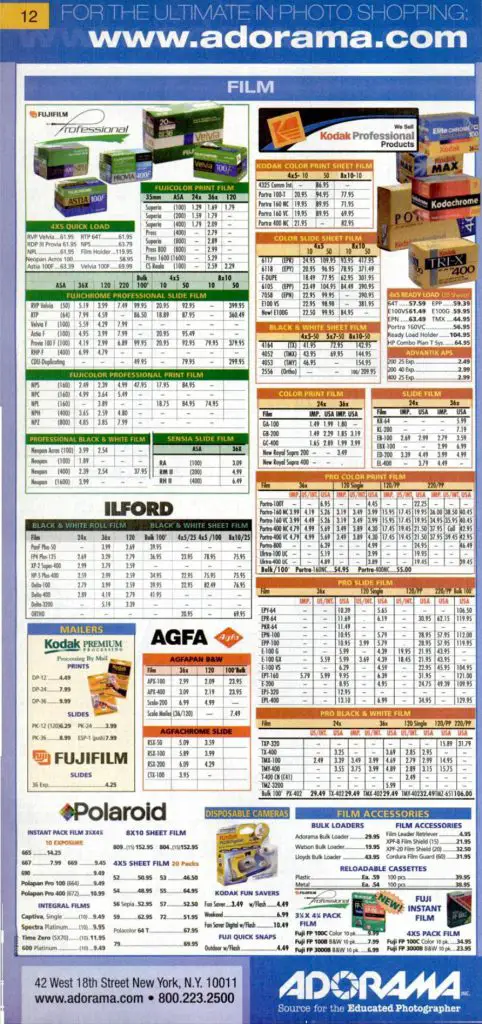 One thing that’s been consistent with all of the prices above, is that they all came from a time prior to the digital camera revolution. We are all aware of how the landscape of photography changed once people upgraded to cameras that no longer required the repeated purchasing of film, but how did that affect the prices?
One thing that’s been consistent with all of the prices above, is that they all came from a time prior to the digital camera revolution. We are all aware of how the landscape of photography changed once people upgraded to cameras that no longer required the repeated purchasing of film, but how did that affect the prices?
This final look comes from Adorama, who still has a strong web presence for film and digital photographers today. This advertisement appeared in the August 2005 issue of Popular Photography and shows quite a number of familiar films.
Here is a selection of prices for some of the more common film stocks that you might use today. All of the prices in Adorama’s ad are film only, without any processing included.
- Kodak Gold 200 24/36 exposure 35mm – $2.29/$3.19
- Kodachrome 64 36 exposure 35mm – $5.99
- Ektachrome 100 36 exposure 35mm – $6.99
- Kodak Portra 160 NC 120/36 exposure 35mm – $3.99/$5.26
- Kodak Ektachrome Pro 64 120/36 exposure 35mm – $6.19/$11.69
- Fuji Superia 100 120/24/36 exposure – $1.79/$1.29/$1.69
- Fuji Superia 800 36 exposure 35mm – $2.99
- Fuji RVP Velvia 50 120/220/36 exposure – $3.99/$7.49/$5.19
- Fuji NPS 160 120/220/36 exposure – $2.39/$4.99/$2.49
- Ilford FP4 PLus 125 120/24/36 exposure – $2.79/$2.69/$3.29
- Ilford Delta 400 120/24/36 exposure – $2.79/$2.89/$4.19
- AGFAPan APX-100 120/36 exposure – $2.09/$2.99
- AGFAChrome RSX-200 120/36 exposure – $4.29/$6.09
- Polaroid Time Zero SX-70 – $11.95
- Fuji Fp-100C Pack Film – $9.99 (HA!)
Once again, we see the same general conclusions as we saw in the 1995 prices where slide film is more expensive than print film, and faster emulsions are more than slower ones.
For most general color film, a 36-exposure roll of 35mm stays in the range of $1.69 to $3.19 for print film and anywhere from $5.99 to $11.69 for slide film. These prices when adjusted for inflation, compare to $2.36 to $4.46 for color print film, and $8.37 to $16.33 for slide film.
Today
So here we are, with almost non stop price hikes by Kodak, Fuji, and Harmon, what does it cost to buy film today?
As I write this, nearly every name brand color film is out of stock and no sites are willing to give an ETA to when they’ll have more, or even what the prices will be when they return.
Since we already looked at Adorama’s ad from 2005, I’m using their current prices to compare modern equivalents to many of the films we already looked at. I’m excluding niche brands like Lomography and dubblefilm who largely sell relabeled cinema film or expired film stocks, but when it comes to Kodak, Fuji, Ilford, and Foma, prices are definitely elevated above the inflation adjusted prices from 2005.
At $6.99, a roll of Kodak Gold 200 is more than 50% higher than it’s inflation adjusted price of $4.46, at $19.99, Kodak E100 (Ektachrome) is more than 30% higher, and at $26.95 Fuji Velvia 50 is more than 370% higher.
If you’ve only been shooting film for the past 15, 10, or even 5 years, the recent price hikes might be shocking as we are nowhere near the rock bottom lows of 2005. Will they ever go down? Maybe, maybe not. No one really knows for sure, but at least be glad that you’re shooting film in 2021 compared to 1921, or even 1981 as prices then would really shock you!


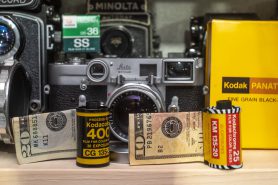
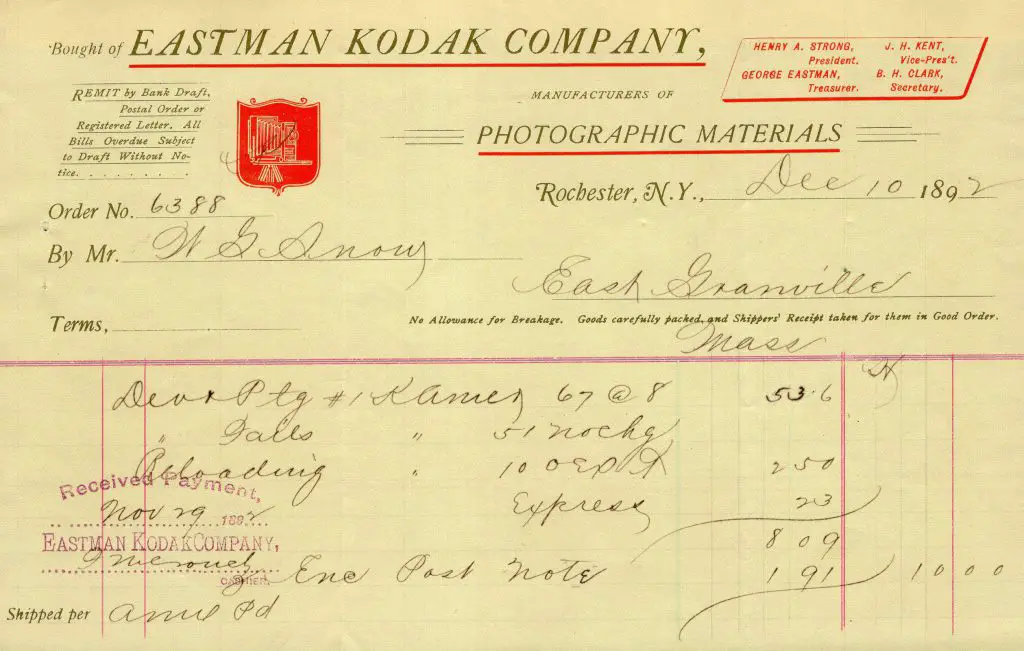
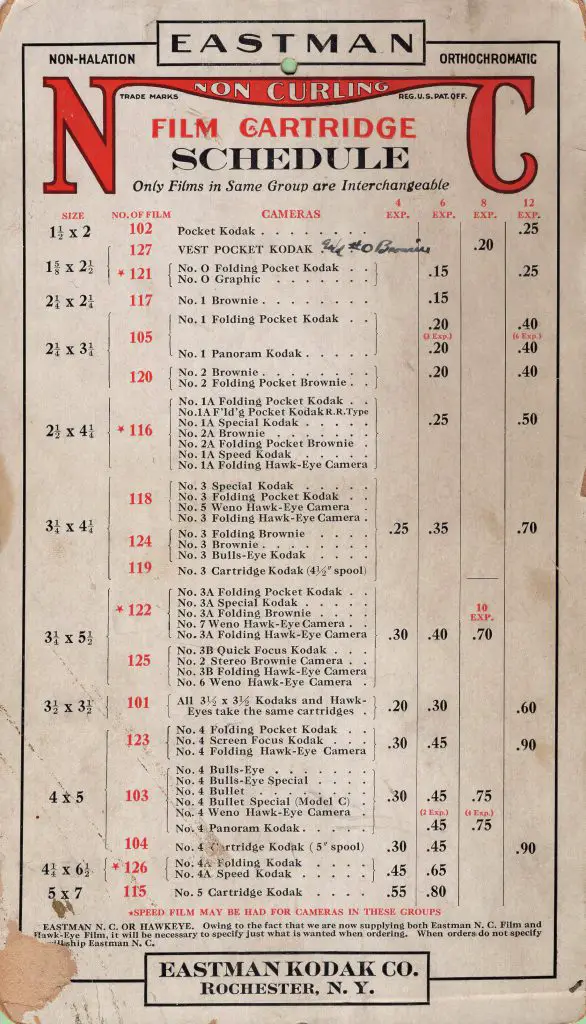
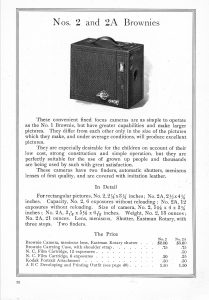

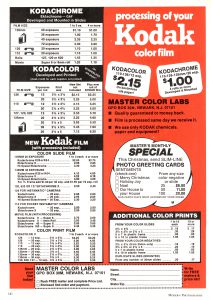
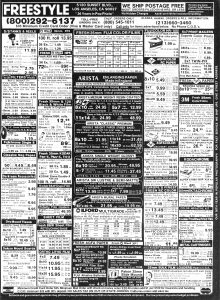











Mike, you’ve access to a very wide range of film stocks and prices going over many decades for your fascinating comparisons.
There is a similar theme in the latest post from James Tocchio on his site Casual Photophile, and which prompted him to suggest ways to reduce costs.
I posted the following comment, which mirrors your far more advanced exercise, but it does show how interesting it can be to do cost comparison exercises. I’ve reposted here, as a complementary view with yours.
“I have validated film prices for up to 1972 here in the UK. 36 exposure FP4 58p, 120 30p. Applying Bank of England inflation factor to 2020, the latest available, the FP4 would cost £7.83 and in 120, £4. My reference store price is £5.83 for 35mm cassette and £4.08 for the 120. So the reality is that 36 exposure cassette of the current FP4 is significantly less expensive than in 1972, whilst the 120 roll is virtually the same.
For colour neg film, Kodacolor-X was 89p and 48p respectively. Today, with inflation, the price would be £12 and £6.48. The actual price of a reference film today is £10.71 (Portra 160) and £9.44. (both as 5-pack prices.) £9.92 and £8.94 (Ektar), ColorPlus £4.24 (35mm only)
I would argue that the true descendant of Kodacolor X is ColorPlus, not the more elaborate emulsions there are today. So in real terms, a film that cost the equivalent of £12 now costs only £4.24.
But the real “killer” in this exercise is the cost of D&P of a 36 exposure film + prints. Wallace Heaton, from whose publication I extracted the 1972 film prices, provided a mail order service and charged 40p to develop the film + 10p per print, so £4 all-in. Today, with inflation, it would be the equivalent of £54, and the print size was just 5 x 3 1/2 inches. The previous company examples I gave, one can have a 36 exposure film developed and printed to 6×4 inches for £10.49.
@James. I’d never really thought about the costs of film photogtaphy today, but going from my examples here, it is no more expensive than in the past, and overall, probably it’s less costly. In the mid-1970’s, here in the UK, High Street labs were fighting for business and we could get a film and 36 6×4 prints for £2.99, equivalent to £22 today. Even adding the price of a ColorPlus to the above quoted price of £10.49, it still comes out less costly today than in the mid-1970’s. The additional cost is that scanner to get ones films into the digital domain.
Film photography’s woes today are more related to a diminishing variety of film types, and to the exaggerated prices being asked for many film cameras which are simply not worth the money.”
Minox subminiature: one roll of 36 exposures slits out into 4 rolls of 36 exposures and two rolls of 24 exposures. Walter Zapp’s little masterpiece just keeps on delivering.
The film companies don’t have a clue. They’re still putting out toxic waste. Personally, I did some development of film in B&W because I read that the chemicals weren’t as bad. Who knows if that is true but I can’t imagine having millions of people dumping chemicals wherever is a good thing. They need to figure out a new process for film that is not an environmental catastrophe waiting to happen.
We’ve been using mostly the same chemicals for 100+ years and in magnitudes of greater volumes in the past than now. Analog photography isn’t zero waste, not by a long shot. But neither is digital – the difference being the impact is up front. The imminent environmental catastrophe is from Exxon and Aramco, not Kodak.
Thank you for sharing this resource, Mike.
The range of prices I’m seeing here is truly expansive: $4-$65.
If this indeed reflects the value of film overtime, it’s safe to assume that photographic emulsions have always had great volatility in their pricing.
Even in 2023, known fresh stocks range between $5 and $35 and you don’t have to look far to find $2 or $FREE expired rolls alongside $100/roll Natura and $300/roll Aerochrome.